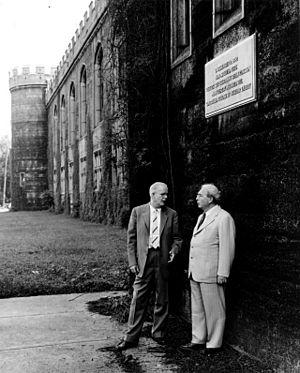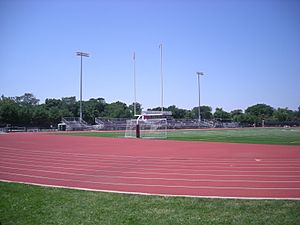Stagg Field facts for kids
Amos Alonzo Stagg Field is the name of two different sports fields at the University of Chicago. The first Stagg Field (used from 1893 to 1957) was named after a famous coach, Alonzo Stagg. It is well-known for a huge scientific discovery.
This first field was the site of the first artificial nuclear chain reaction. This amazing event happened during World War II as part of the Manhattan Project. The spot where this experiment took place is now a National Historic Landmark. It also became a Chicago Landmark.
Today, a sculpture called Nuclear Energy by Henry Moore marks the exact location. The University's current Stagg Field is a few blocks away. It is used for football, soccer, and track. It even has one of the original gates from the old field.
Contents
First Nuclear Chain Reaction: A Big Discovery
Chicago Pile-1 was the world's first artificial nuclear reactor. It was built in a squash court. This court was hidden under the west stands of the old Stagg Field. By then, the field was no longer used for football games.
On December 2, 1942, scientists achieved something incredible. They created the first man-made, self-sustaining nuclear chain reaction. This was a huge step in understanding nuclear energy.
Stagg Field: A Place for Sports
The Original Stagg Field (1893-1957)
The first Stagg Field was a large stadium in Chicago. It was located at the University of Chicago. This stadium was mainly used for college football games. It was the home field for the Maroons team.
The stadium first opened in 1893 as Marshall Field. It was named after Marshall Field, who gave land for the university to build it. In 1913, the field was renamed Stagg Field. This honored their famous coach, Amos Alonzo Stagg. After growing several times, the stadium could hold 50,000 people.
The University of Chicago stopped its football program after 1939. They also left the Big Ten Conference in 1946. The stadium was torn down in 1957. A large part of its site is now where the Regenstein Library stands.
Besides football, the stadium hosted many other events. It held the USA Outdoor Track and Field Championships several times. It also hosted the NCAA Division I Men's Outdoor Track and Field Championships many times in the 1920s and 1930s.
Other teams also played here. The Northwestern team played some home games at Stagg Field. This happened when their own stadium could not handle large crowds. For example, they played against Michigan in 1925 and won.
The famous University of Michigan fight song, "The Victors," was written in 1898. It was created after Michigan won a close game against the University of Chicago at Stagg Field. That game decided the Western Conference championship.
The New Stagg Field (Current)
The current Stagg Field is an athletic field located a few blocks away. It keeps the Stagg Field name alive. It even has a gate from the original stadium. This field is used by the school's current Division III football team.
It is also home to the Chicago Maroons soccer, softball, and outdoor track teams. The new Stagg Field can seat about 1,650 people. Its playing surface is made of FieldTurf.
See also




